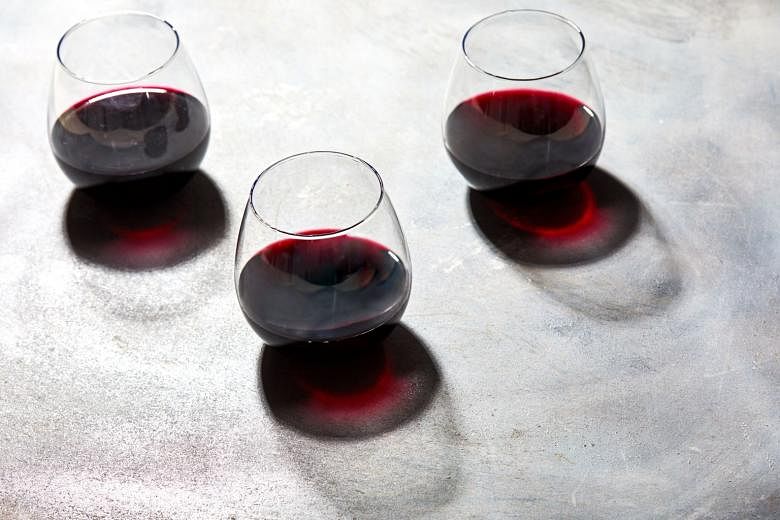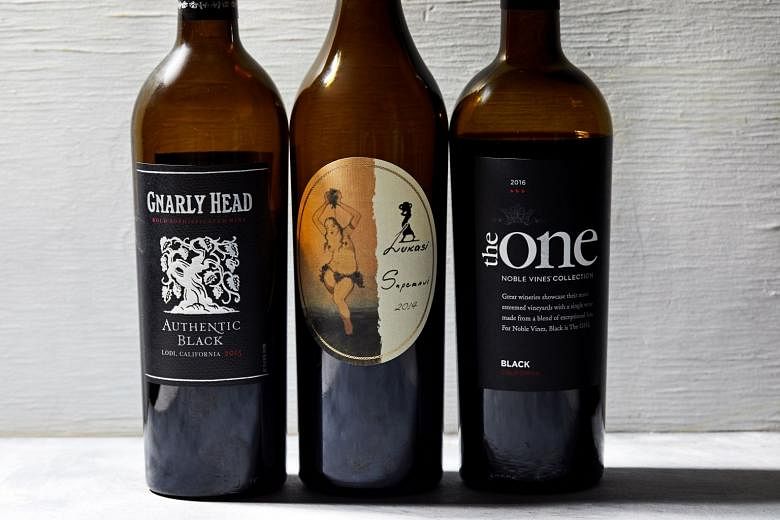(THE WASHINGTON POST) - Name all the colours of wine, and you'll start with the obvious ones: red, white and pink, or rose. Maybe you know about orange wine, or vinho verde - "green wine" from Portugal that's technically a white, but we'll let it slide.
There's even blue wine (we taste-tested it; it was mostly gross).
It's time to add another colour to your wine rainbow: Black.
First things first: Black wine isn't black because of food colouring or some sort of food science trickery. Blue wine, for example, gets its blue colour from anthocyanin, a pigment found in grape skins, and indigotine, a dye extracted from plants. But black wine is just very dark red wine. When you pour it, its legs - the streaks that appear on the inside of the glass - will appear red, but if you put your hand under the glass and look down, it will appear inky and completely opaque.
Black wines vary in flavour profiles - we sampled a few that ranged from lighter to full-bodied and tart to sugary-sweet - but a common element seems to be the flavour of blackberry.
There are professional wine writers who can opine at length about black wine and its centuries-long history - how it comes from malbec or saperavi grapes, how it hails from France or the country of Georgia, how it has a bold flavour that can "stand up to rich and hearty fare such as foie gras, black truffles, beef, game meats, duck confit and cassoulet," wrote Michael Austin in the Chicago Tribune. But what we're here to talk about is how the colour black - or nearly black, in this case - is gaining ground in the food world.
It's Newton's Third Law of Motion, but applied to trends: Every action has an equal and opposite reaction. So, as your Instagram gets filled up with rainbows and unicorns and Crystal Ball Frappuccinos and edible glitter, the backlash to that is dark, Gothic-tinted food. Lately, some of it has been getting its hue from activated charcoal, a controversial ingredient that some say cleanses toxins from the body. Nutritionists, on the other hand, say it can interfere with medication and have harmful effects in certain quantities. But chefs, and health food cafes in particular, have been putting it in plenty of things - fresh-pressed juices, lemonades, ice cream and pizza crusts.
Charcoal isn't the only way to tint food black. Squid ink, too, has been popping up in unusual places, like bao and baguettes. Coconut ash, a type of activated charcoal, is the star ingredient in one New York coffee shop's "matte black latte." And in 2015, for a Halloween stunt, Burger King used A1 Steak Sauce to turn its Whopper buns black (but there were some, um, unsavoury side effects). Black sesame, seaweed and garlic have also been showing up on more and more menus.
And now black wine is on the upswing, which some wine writers credit to Instagram. It's a counterpoint to the super-girly fetishisation of rose and the lifestyle that accompanies it - rose bachelorette parties, rose-themed patios, and even a playlist called rosewave. Data released by Nielsen indicates that rose has been one of the fastest-growing segments of the market for two years running.
But maybe #roseallday belongs to an earlier, more optimistic era. Maybe now, since we are in the darkest timeline, is the perfect time for black wine - a dark wine for thinking dark thoughts. Look deep into your glass and you'll feel like you're staring into the abyss.


